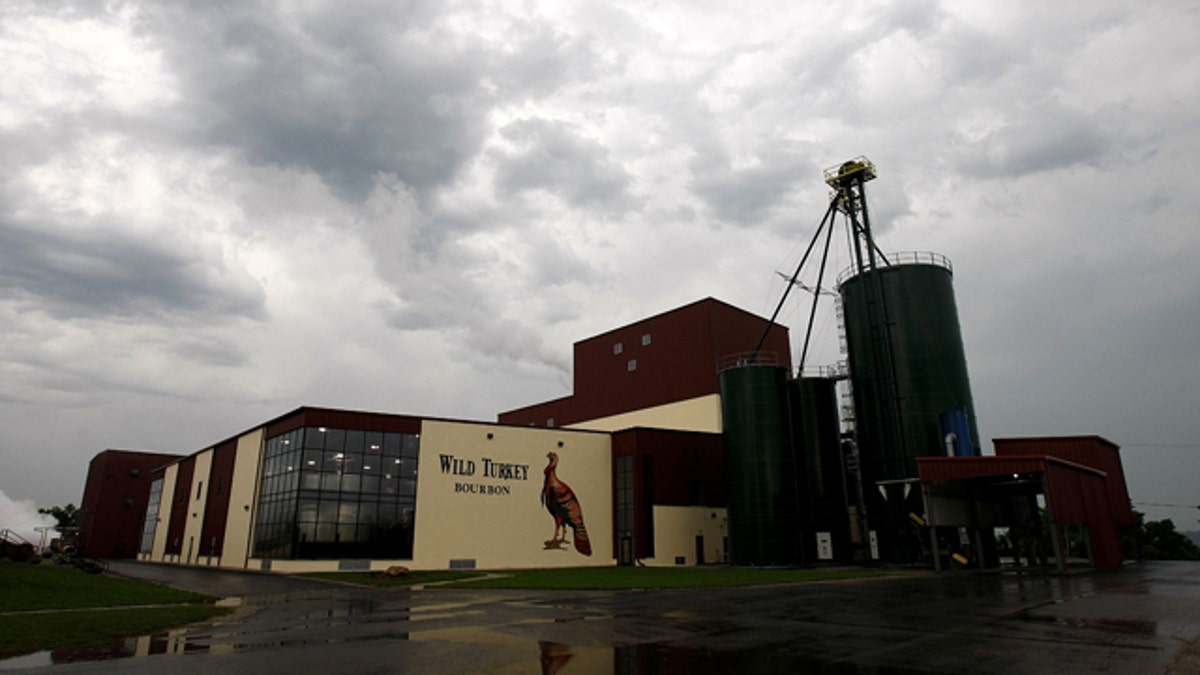
(AP)
LAWRENCEBURG, Ky. – At the new Wild Turkey bourbon distillery in central Kentucky, the grainy smell of fermenting corn wafts from giant tubs as workers add a touch of grain or tweak the temperature, just as they had for decades at the now-mothballed plant nearby.
The difference? They can make more than twice as much bourbon at the new $50 million facility, with room to grow if sales keeps spiking. In a nod to the automation that took hold years ago, workers in a control room lined with computers can adjust their brew with a few keystrokes. It's among the most ambitious of projects for this industry clustered in central Kentucky's rolling hills, where distilleries have spent at least $150 million in one of the bourbon sector's biggest expansions since Prohibition, said Eric Gregory, president of the Kentucky Distillers' Association.
The producers are aiming to quench a thirst for bourbon — especially premium brands — that is steady in the U.S. and rapidly expanding overseas, thanks in part to the comeback of cocktails appealing to younger adults, lower tariffs, robust marketing and a larger middle class in emerging markets.
"It used to be if you went West and crossed the Mississippi, it was hard to even find a bourbon," said Eddie Russell, Wild Turkey's associate distiller and son of longtime master distiller Jimmy Russell. Wild Turkey is showing off the new distillery at a ceremony Tuesday — though the bourbon aging there won't be ready for sipping until 2016.
Kentucky produces 95 percent of the world's bourbon, according to the state distillers' association. More than 5 million barrels of bourbon and other whiskeys are currently aging in the state, the highest inventory since the early 1980s. The 4.7 million barrels of aging bourbon even outnumbers the state's population of 4.3 million.
The proliferation of small-batch premium and super-premium products, which are aged longer and fetch higher retail prices, has helped propel sales and given bourbon a more cosmopolitan image.
Mike Ryan, head bartender at Sable Kitchen & Bar in Chicago, said fine bourbons are increasingly in the mix among consumers with a taste for classics like the Manhattan and Old Fashioned, as well as new concoctions popular with younger adults.
"It actually provides a much more interesting backdrop for flavors than does something neutral like vodka," he said.
A complex blend of flavors, especially in premium brands, can yield vanilla, citrus and fruit tastes, making bourbon an ideal mixer, he said.
Industry observer F. Paul Pacult, editor of the quarterly newsletter Spirit Journal, said bourbon makers are showing an adventurous side with premium offerings that reflect an "intramural competition."
"There's more innovation happening in Kentucky right now than any other place in the world," Pacult said.
Maker's Mark, known for its red wax seal, is in the midst of an estimated $50 million expansion that will boost production by about 50 percent and expand bottling capacity at its operations near Loretto in central Kentucky.
In the next six years, it plans to build 20 to 25 new warehouses needed for storing barrels of whiskey that will age no fewer than six years.
The brand, part of the spirits lineup for Deerfield, Ill.-based Fortune Brands Inc., surpassed 1 million cases bottled for the first time in 2010.
"I've witnessed a total transformation of the bourbon industry," said Bill Samuels Jr., chairman emeritus of Maker's Mark bourbon. "It's gone from a disrespected swill to the selection of connoisseurs and young trendsetters the world over."
Jim Beam, also owned by Fortune Brands, is the world's top-selling bourbon. Beam is pumping $18 million into upgrading its visitor center and making other improvements at its Clermont plant to accommodate growing numbers of tourists flocking to distilleries along the Kentucky Bourbon Trail, which features six distilleries that give tours. It is also spending $26 million to expand its bottling operation in the state capital, Frankfort.
Heaven Hill Distilleries Inc., whose brands include Evan Williams bourbon, added two storage warehouses earlier this year, boosting its capacity by about 40,000 barrels at a cost of about $5 million. The company is eyeing improvements to its bottling facilities to keep the momentum going.
The Four Roses, Buffalo Trace and Woodford Reserve distilleries also have put money into upgrading visitor centers.
One of Kentucky's most popular tourist destinations, the Bourbon Trail has averaged double-digit percentage growth in the past five years, with nearly 2 million people visiting at least one distillery during the period, Gregory said.
In the U.S., 15.4 million 9-liter cases of bourbon and Tennessee whiskey sold in 2010, generating $1.9 billion in revenues for distillers, according to statistics from the Distilled Spirits Council of the United States, a national trade association. In 2003, 13.4 million cases sold, yielding $1.3 billion in revenues.
The industry's biggest boost, though, has come from exports.
Producers of bourbon and Tennessee whiskey reaped $768.2 million in export sales in 2010, up from $303.8 million in 2000, according to the spirits council, citing statistics from the U.S. Department of Commerce and the U.S. International Trade Commission.
The biggest overseas customers include Australia, Japan, the United Kingdom and Germany, but the industry is looking at two seemingly bottomless markets — China and India — along with other emerging markets in Asia and Africa.
Russell, who has 30 years at Wild Turkey, has ambitious plans, with hopes the new distillery will need to be expanded in just a few years.
"This is a crucial time for all of us to put our product out there and put our best foot forward for the world," he said.
